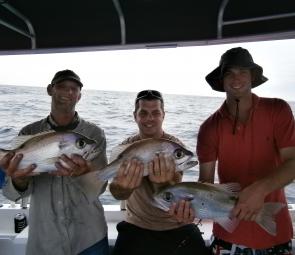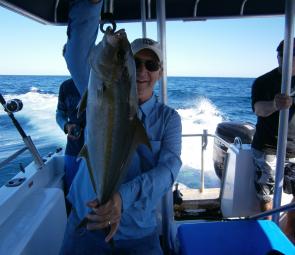Snapper and big pearlies have been on the menu of late and as we roll into July the run will continue. Water temps will drop off nicely and good numbers on the 60m line in the northern areas of Wide Caloundra will continue to chew their way into the box.
Early morning and run-out tide has produced the better action using the paternoster with fresh flesh baits and squid first choice for that rig. The humble butterfish (aka Caloundra special) go particularly well fleshed down for the snapper so don’t throw them back, flesh them up and convert them into a red or pearl perch. The same goes for other by-catch that does not have any legal sizes attached. Fresh is best.
Float-lining a lightly weighted whole pillie is also accounting for some good snapper with the currents and water flow in the 60m area a little more stable and predictable than the wider grounds where there can be ripping current one day and virtually none the next. Winter does tend to be more manageable and better paced but still a variable like weather that can make or break a trip out wide.
The key to a good float-lining day is the presentation of the pillie; keep its movement as natural and free as possible. The lightest possible sinker should be used and it may take a drift or two in the area to work out the correct weight to get you down in time over the show versus presentation factor. It becomes a trade-off for depth, current run and length of the drift that only trial and error will resolve.
A 4 ball sinker in most cases is sufficient, up to a 6 on a day with a bit of run. A small piece of cut fluoro tube or small fluoro balls placed on the line between the sinker and hooks also raise the interest factor of the fish and improve catch rates.
Standing out and grabbing attention of the fish as you drop through the depths. The bigger snapper will in most cases be up off the bottom in the mid to lower depths with your pillie drifting down through those mid depths. Check your sounder for fish depths and small shows off the bottom as that’s where the bigger fish will be holding.
You want your bait to sink slowly and the depth is achieved by feeding out line. Non-stop ‘feeding the chooks’, as I call it, until a hook up. The lighter the sinker the more line, but a simple rule is just keep feeding the chooks.
Best rig to do that is a bait runner. It allows easy line feeding and quick response to strike. We use Shimano Baitrunners with 30lb mono, which is a tad heavy, but being a Charter operation we are restricted with how many rigs and set ups we can use with eight people fishing. In a perfect world we would need 30 rods and reels aboard!
Float-lining is one of those bang, hook-up scenarios in most cases. Great fun and the buzz we all go fishing for. You will get times when you feel a couple of hits but just keep feeding line out until either the peckers stop or you hook up. The mozzies have nutted you so pull up and get down again.
Mono is the best line to use for this for its stretch factor as you really do not need to feel the fish and strike. They monster it; snapper will go bang and run. No tap, tap, just line peeling off, so when you do engage the fish the stretch gives you some shock value and eases you into the fight rather than a sudden connection like braid.
For hooks, two 5/0 ganged is a simple and preferred method or a 3 hook snood rig.
If the 60-80m line is slow, the 100m line and small trawler wrecks dotted through that area are also a go-to spot in July. Work out to a depth of 140m, if you have the stamina, but the trip and effort will on most occasions be rewarded with prize pearlies.
These areas can also hold yellowtail kingfish, on the right day. It is handy to have your live bait tank well stocked for this particular area as the bigger pearlies and knobbies will latch onto a livie and the kingies will hang off the same formations.
A word of warning for navigating out for a fish on Wide Caloundra . If you do fish Wide Caloundra, and it’s been a while between trips, be a bit wary if you are coming out of Scarborough or a course that takes you over or near the Spitfire Banks to go out via Combi Point.
The Tangalooma end of them have shown an ugly side over the past months with some very rough and rugged and shallow water throwing up some stand up waves. It is a cross directional washing machine on the run-out tide when there is a bit of swell about.
Night fishing in winter is a popular time, so be wary coming home or going out of that area. The state of the tide and swell could cause a small boat some significant grief if on a dark night you find yourself in the middle of it. A wide berth of that area is the best option to a safe trip, sticking to the deeper water rather than a straight line to Combi.
Reads: 1592
You will find prize pearlies out on the 100m line at depths of 140m.

You will find yellowtail kingfish in similar areas to big pearlies and knobbies.




